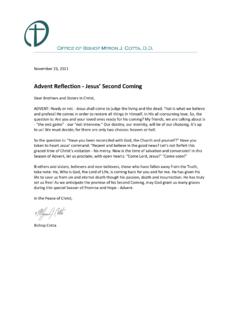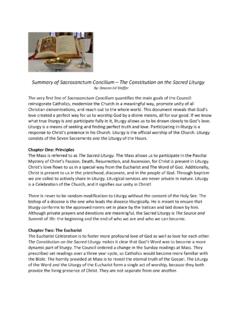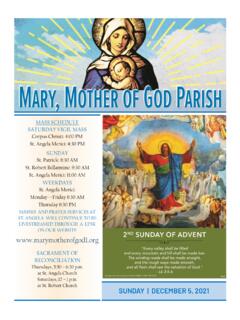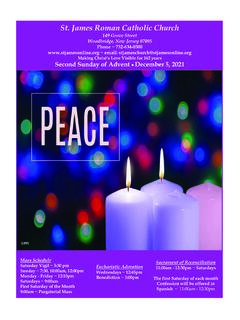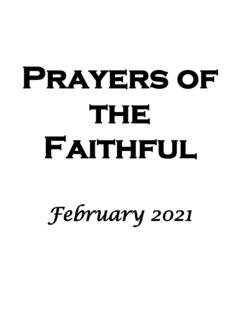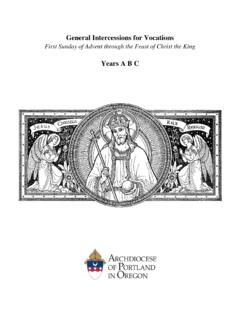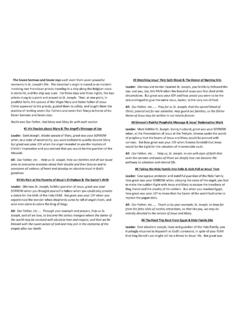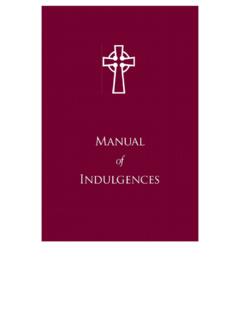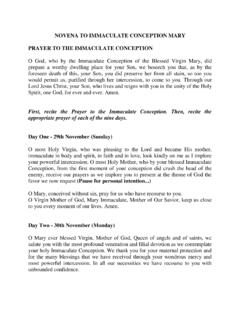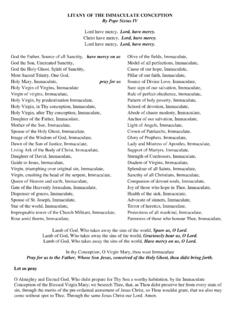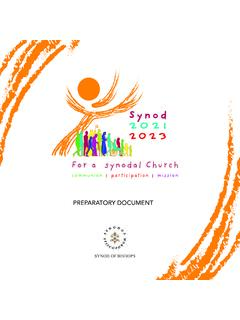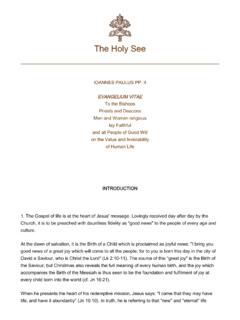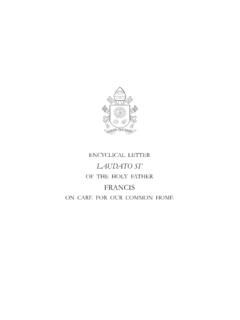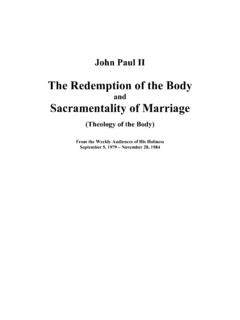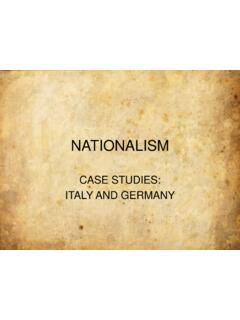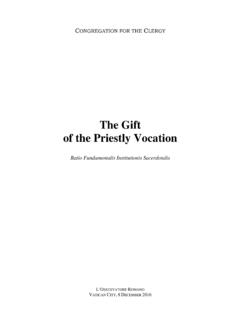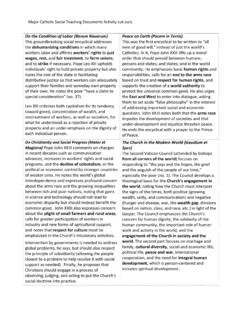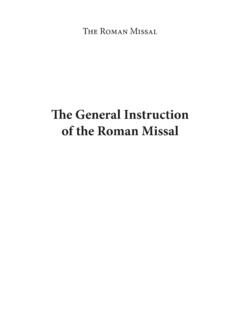Transcription of GENERAL INSTRUCTION OF THE ROMAN MISSAL
1 GENERAL INSTRUCTION OF THE ROMAN MISSAL . Concordat cum originali: + Most Rev. Gregory M. Aymond Chairman, USCCB Committee on Divine Worship after review by Rev. Richard B. Hilgartner Executive Director, USCCB Secretariat of Divine Worship The ROMAN MISSAL , Third Edition for use in the Dioceses of the United States of America was confirmed by decree of the Congregation for Divine Worship and the Discipline of the Sacraments on March 26, 2010 (Prot. n. 1464/06/L). Proper adaptations for the United States were confirmed on July 24, 2010 (Prot. n. 577/10/L). Excerpts from the English translation of The ROMAN MISSAL 2010 International Commission on English in the Liturgy Corporation.. All rights reserved. Particular adaptations for the Dioceses of the United States of America 2010 United States Conference of Catholic Bishops, Washington, DC. All rights reserved. Copyright 2011, United States Conference of Catholic Bishops, Washington, DC. All rights reserved. No part of this work may be reproduced or transmitted in any form or by any means, electronic or mechanical, including photocopying, recording, or by any information storage and retrieval system, without permission in writing from the copyright holder.
2 T AB LE OF C O NTE NT S. Table of Contents Foreword to this Edition Introduction Chapter I: The Importance and Dignity of the Celebration of the Eucharist Chapter II: The Structure of the Mass, Its Elements, and Its Parts Chapter III: Duties and Ministries in the Mass Chapter IV: The Different Forms of Celebrating Mass Chapter V: The Arrangement and Ornamentation of Churches for the Celebration of the Eucharist Chapter VI: The Requisites for the Celebration of Mass Chapter VII: The Choice of the Mass and Its Parts Chapter VIII: Masses and Prayers for Various Needs and Occasions and Masses for the Dead Chapter IX: Adaptations within the Competence of Bishops and Bishops' Conferences FOREWORD TO THIS EDITION. November 27, 2011, marks a significant date in the liturgical life of the Church in the United States as the ROMAN MISSAL , Third Edition, is introduced and put into use for the celebration of the Eucharist. This brings to conclusion the work of more than ten years of research, translation, preparation, and study.
3 The implementation of the new translation of the prayers of the Mass is probably the most significant change in the liturgy since the introduction of the novus ordo MISSAL of Pope Paul VI in 1969. The text of the GENERAL INSTRUCTION of the ROMAN MISSAL (GIRM) from the Missale Romanum, editio typica tertia, was translated and approved for the Dioceses of the United States in 2003 and was subsequently published as part of the United States Conference of Catholic Bishops' (USCCB) Liturgy Documentary Series. The final text of the ROMAN MISSAL , Third Edition, for use in the Dioceses of the United States and approved in 2010, includes a new translation of the GIRM. The 2003 text was intended as a provisional translation, and in subsequent years other English-language Conferences of Bishops issued their own translations of the GIRM. The translation contained here and also in the ritual edition of the ROMAN MISSAL , Third Edition, is now the single official translation for the English-speaking world.
4 Also included in this edition are two other valuable documents: The Universal Norms for the Liturgical Year and the ROMAN Calendar and the Norms for the Distribution and Reception of Holy Communion under Both Kinds for the Dioceses of the United States of America, both of which also appear in front matter of the ROMAN MISSAL , Third Edition. Together with the GIRM these documents provide a comprehensive overview and INSTRUCTION for the celebration of the Mass. Pope Benedict XVI reminds the Church that the Liturgy follows the ancient axiom, Lex orandi, lex credendi ( the law of faith is the law of belief ). Not only is it a matter of words that communicate the faith of the Church, but the way in which the Liturgy is celebrated witnesses to what we believe. Pope Benedict explains: These texts contain riches which have preserved and expressed the faith and experience of the People of God over its two- thousand-year history. Equally important for a correct ars celebrandi is an attentiveness to the various kinds of language that the liturgy employs: words and music, gestures and silence, movement, the liturgical colors of the vestments.
5 By its very nature the liturgy operates on different levels of communication which enable it to engage the whole human person. (Sacramentum Caritatis, no. 40). May our study and observance of liturgical norms and rubrics continue to foster prayerful and fruitful celebration of the Eucharist, that this moment in the renewal of the Liturgy will strengthen us for the ongoing renewal of the Church. Rev. Richard B. Hilgartner Executive Director USCCB Secretariat of Divine Worship CHAPTER I: THE IMPORTANCE AND DIGNITY OF THE. CELEBRATION OF THE EUCHARIST. 16. The celebration of Mass, as the action of Christ and of the People of God arrayed hierarchically, is the center of the whole of Christian life for the Church both universal and local, as well as for each of the faithful individually.[22] For in it is found the high point both of the action by which God sanctifies the world in Christ and of the worship that the human race offers to the Father, adoring him through Christ, the Son of God, in the Holy Spirit.
6 [23] In it, moreover, during the course of the year, the mysteries of redemption are celebrated so as to be in some way made present.[24]. As to the other sacred actions and all the activities of the Christian life, these are bound up with it, flow from it, and are ordered to it.[25]. 17. It is, therefore, of the greatest importance that the celebration of the Mass or the Lord's Supper be so ordered that the sacred ministers and the faithful taking part in it, according to the state proper to each, may draw from it more abundantly[26] those fruits, to obtain which, Christ the Lord instituted the Eucharistic Sacrifice of his Body and Blood and entrusted it as the memorial of his Passion and Resurrection to the Church, his beloved Bride.[27]. 18. This will fittingly come about if, with due regard for the nature and other circumstances of each liturgical assembly, the entire celebration is arranged in such a way that it leads to a conscious, active, and full participation of the faithful, namely in body and in mind, a participation fervent with faith, hope, and charity, of the sort which is desired by the Church and which is required by the very nature of the celebration and to which the Christian people have a right and duty in virtue of their Baptism.
7 [28]. 19. Even though it is on occasion not possible to have the presence and active participation of the faithful, which manifest more clearly the ecclesial nature of the celebration,[29] the celebration of the Eucharist is always endowed with its own efficacy and dignity, since it is the act of Christ and of the Church, in which the Priest fulfills his own principal function and always acts for the sake of the people's salvation. Hence the Priest is recommended to celebrate the Eucharistic Sacrifice, in so far as he can, even daily.[30]. 20. Since, however, the celebration of the Eucharist, like the entire Liturgy, is carried out by means of perceptible signs by which the faith is nourished, strengthened, and expressed,[31] the greatest care is to be taken that those forms and elements proposed by the Church are chosen and arranged, which, given the circumstances of persons and places, more effectively foster active and full participation and more aptly respond to the spiritual needs of the faithful.
8 21. Hence this INSTRUCTION aims both to offer GENERAL lines for a suitable ordering of the celebration of the Eucharist and to explain the rules by which individual forms of celebration may be arranged.[32]. 22. The celebration of the Eucharist in a particular Church is of the utmost importance. For the Diocesan Bishop, the prime steward of the mysteries of God in the particular Church entrusted to his care, is the moderator, promoter, and guardian of the whole of liturgical life.[33] In celebrations that take place with the Bishop presiding, and especially in the celebration of the Eucharist by the Bishop himself with the Presbyterate, the Deacons, and the people taking part, the mystery of the Church is manifest. Hence, solemn celebrations of Mass of this sort must be exemplary for the entire diocese. The Bishop should therefore be determined that the Priests, the Deacons, and the lay Christian faithful grasp ever more deeply the genuine significance of the rites and liturgical texts, and thereby be led to the active and fruitful celebration of the Eucharist.
9 To that end, he should also be vigilant in ensuring that the dignity of these celebrations be enhanced and, in promoting such dignity, the beauty of the sacred place, of the music, and of art should contribute as greatly as possible. 23. Moreover, in order that such a celebration may correspond more fully to the prescriptions and spirit of the Sacred Liturgy, and also in order that its pastoral effectiveness be enhanced, certain accommodations and adaptations are set out in this GENERAL INSTRUCTION and in the Order of Mass. 24. These adaptations consist, for the most part, in the choice of certain rites or texts, that is, of the chants, readings, prayers, explanatory interventions, and gestures capable of responding better to the needs, the preparation, and the culture of the participants and which are entrusted to the Priest Celebrant. However, the Priest will remember that he is the servant of the Sacred Liturgy and that he himself is not permitted, on his own initiative, to add, to remove, or to change anything in the celebration of Mass.
10 [34]. 25. In addition, at the proper place in the MISSAL are indicated certain adaptations which in accordance with the Constitution on the Sacred Liturgy pertain respectively to the Diocesan Bishop or to the Conference of Bishops[35]. (cf. below nos. 387, 388-393). 26. As for variations and the more profound adaptations which give consideration to the traditions and culture of peoples and regions, to be introduced in accordance with article 40 of the Constitution on the Sacred Liturgy, for reasons of usefulness or necessity, those norms set out in the INSTRUCTION on the ROMAN Liturgy and Inculturation[36] and below in nos. 395-399 are to be observed. F O OT N OT ES. [22] Cf. Second Ecumenical Council of the vatican , Constitution on the Sacred Liturgy, Sacrosanctum Concilium, no. 41; Dogmatic Constitution on the Church, Lumen gentium, no. 11; Decree on the Ministry and Life of Priests, Presbyterorum ordinis, nos. 2, 5, 6; Decree on the Pastoral Office of Bishops, Christus Dominus, no.
